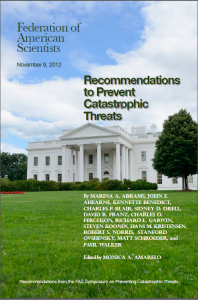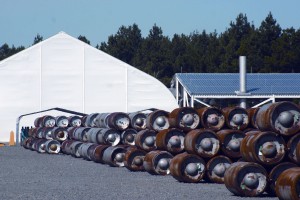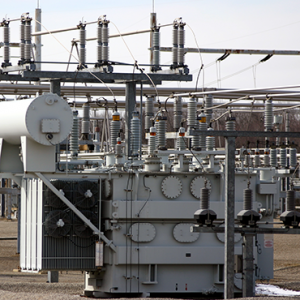
Earlier this month the Federation of American Scientists held its annual Symposium on Catastrophic Threats and Awards Ceremony at the National Press Club in Washington, D.C. The date – November 9th – was chosen to coincide with the November U.S. presidential election and provide a forum for policy recommendations to a newly elected administration. The symposium provided a wonderful venue for the discussion of the most-pressing threats facing the U.S. Panelists called for steps to prevent catastrophic events, and increase response planning and preparation to those possible dangers. These recommendations were published in a booklet, available electronically.
Because science plays such a critical role in underlying U.S. policies, from disaster preparation to farm subsidies, leaders must be armed with a science-based knowledge of the risks and opportunities policy choices present. To this end, the symposium featured moderated discussions of four-to-five distinguished experts, grouped into related threat-areas: Nuclear Weapons; Biological, Chemical, Conventional, and Cyber Threats; and Energy and Infrastructure.
The session devoted to nuclear threats reiterated the group’s long-held goals of stockpile reduction and eventual total disarmament. Senior FAS Fellow Charles Blair emphasized that the U.S. must start differentiating violent non-state actors in terms of their ability to pose a bona fide radiological or nuclear (R/N) threat, rather than treating all threats as possessing equal capabilities. Proper identification of the threat will allow targeted policies and avoid wasteful expenditures of time and resources on groups that do not pose significant R/N threats. Another FAS Fellow, Dr. Robert Norris, proposed that a fundamental alteration of Cold-War era nuclear doctrine is a prerequisite for arms reduction, with a minimal deterrence mission the only necessary use for the U.S. nuclear arsenal.
Lengthy discussions of biological-, chemical-, and conventional-weapons threats highlighted the need for increased accountability and controls, which are scarcer outside the United States. Perhaps the most significant threat in the chemical and biological weapons fields stems from the fact that there is a growing dearth of technical experts in the former Soviet Union to handle existing stockpiles of agents. Without the incentives of prestige and financial rewards available during the years of the thriving Soviet weapons programs, even fewer personnel with the requisite training will be available to handle and safeguard stockpiles in the future.

The energy and infrastructure panel spoke in favor of nuclear energy with reminders that natural gas does not eliminate greenhouse gas production. They also reminded attendees that the U.S. will likely import oil from Canada long after it frees itself of overseas imports. Dr. Steven Koonin, of NYU, called for increased funding for alternative energy research and a reorganization of the Department of Energy to enable better understanding of markets and business policies. Notably absent from the discussion was an in-depth assessment of the impact that the Fukushima Daiichi incident will generally have on nuclear power endeavors in the future, and in Japan specifically.
One subject that stood out for immediate attention is developing a framework for rules and definitions in cyber security and warfare. The United States is ill-prepared to respond to a major denial of service attack aimed at critical infrastructure, especially in the cyber realm. Dr. Kennette Benedict, from the Bulletin of Atomic Scientists, explained that the field lacks clarity on responsibilities and acceptable scope for security. Increasingly sophisticated attacks on private and public networks demand a robust effort to ensure reliability and freedom from interference. While the private sector has tremendous incentives to shore up defenses against intrusion and would benefit from federal support in defending network architecture, transparency and trust are in short supply at this time.
As an illustration, were a major electrical grid or other critical infrastructure component attacked, resulting in losses of life and industrial output, how would the United States respond? Would this be defined an act of terror an act of war? Would the response be treated like a natural disaster? No clearly defined roles have been established for preventing and/or prosecuting major acts of cybercrime. No public forum exists to discuss the norms associated with cyber warfare, define acceptable measures that may be taken against individual or state-sponsored actors, or set limits to intrusion that occurs under the guise of security.

Not only will clarifying these issues benefit the private sector, but transparency will also pay major dividends in foreign policy negotiations. As with any new weapon, uncertainty will lead to mistrust and fear, which often precipitate wasteful arms races. U.S. leaders must come to the table with candor in order to develop policies that promote security with minimal interference for all. A massive blackout or disruption of services would be devastating for everyone; CIMSEC could be the group that suggests a way forward.
More information about the event can be found at the Federation of American Scientists’ website: www.fas.org

